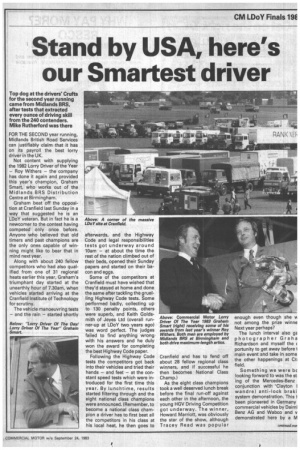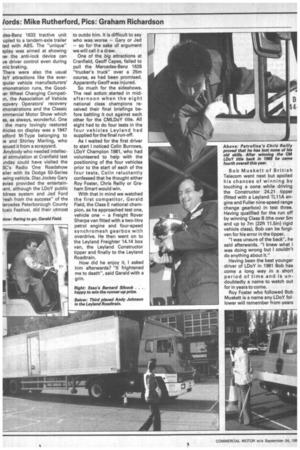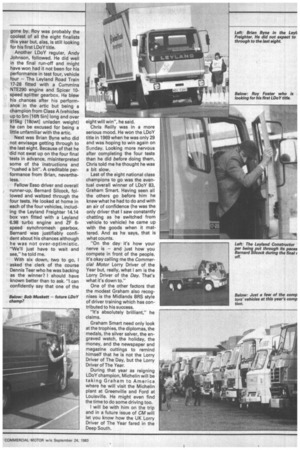Stand by USA, here's our Smartest driver
Page 85

Page 86

Page 87

If you've noticed an error in this article please click here to report it so we can fix it.
FOR THE SECOND year running, Midlands British Road Services can justifiably claim that it has on its payroll the best lorry driver in the UK.
Not content with supplying the 1982 Lorry Driver of the Year — Roy Withers — the company has done it again and provided this year's champion, Graham Smart, who works out of the Midlands BRS Distribution Centre at Birmingham.
Graham beat off the opposition at Cranfield last Sunday in a way that suggested he is an LDoY veteran. But in fact he is a newcomer to the contest having competed only once before. Anyone who believed that old timers and past champions are the only ones capable of winning might like to bear that in mind next year.
Along with about 240 fellow competitors who had also qualified from one of 31 regional heats earlier this year, Graham's triumphant day started at the unearthly hour of 7.30arri, when vehicles started arriving at the Cranfield Institute of Technology for scrutiny.
The vehicle manoeuvring tests — and the rain — started shortly afterwards, and the Highway Code and legal responsibilities tests got underway around 10am — at about the time the rest of the nation climbed out of their beds, opened their Sunday papers and started on their bacon and eggs.
Some of the competitors at Cranfield must have wished that they'd stayed at home and done the same after tackling the gruelling Highway Code tests. Some performed badly, collecting up to 130 penalty points, others were superb, and Keith Goldsmith of Jeyes Ltd (overall runner-up at LDoY two years ago) was word perfect. The judges failed to find anything wrong with his answers and he duly won the award for completing the best Highway Code paper.
Following the Highway Code tests the competitors got back into their vehicles and tried their hands — and feet — at the constant speed tests which were introduced for the first time this year. By lunchtime, results started filtering through and the eight national class champions were announced. (Remember, to become a national class champion a driver has to first beat all the competitors in his class at his local heat, he then goes to Cranfield and has to fend off about 28 fellow regional class winners, and if successful he then becomes National Class Champ.) As the eight class champions took a well deserved lunch break before the final run-off against each other in the afternoon, the young HGV Driving Competition got underway. The winner, Howard Marriott, was obviously the star of the show, although Tracey Read was popular enough even though she not among the prize winne Next year perhaps?
The lunch interval also ga photographer Graha Richardson and myself the c portunity to get away before I main event and take in some the other happenings at Cri field.
Something we were bc looking forward to was the st ing of the Mercedes-Benz conjunction with "Clayton wandre) anti-lock braki system demonstration. This been pioneered in Germany commercial vehicles by Daiml Benz AG and Wabco and v demonstrated here by a M
des-Benz 1633 tractive unit upled to a tandem-axle trailer ted with ABS. The "unique" splay was aimed at showing )w the anti-lock device can ve driver control even during inic braking.
There were also the usual 1(3Y attractions like the ever)pular vehicle manufacturers' Imonstration runs, the Goodtar Wheel Changing Competixi, the Association of Vehicle )covery Operators' recovery Imonstrations and the Classic )mmercial Motor Show which as, as always, wonderful. One the many lovingly restored :hides on display was a 1947 xfford M-Type belonging to )e and Shirley Marling, who scued it from a scrapyard.
Anybody who needed intellecal stimulation at Cranfield last Jnday could have visited the BC's Radio One Roadshow ailer with its Dodge 50-Series ,wing vehicle. Disc Jockey Gary avies provided the entertainlent, although the LDoY public Jdress system and Jed Ford 'resh from the success" of the lercedes Peterborough County lusic Festival, did their utmost
to outdo him. It is difficult to say who was worse — Gary or Jed — so for the sake of argument we will call it a draw.
One of the big attractions at Cranfield, Geoff Capes, failed to pull the Mercedes-Benz 1628 "trucker's truck" over a 25m course, as had been promised. Apparently Geoff was injured.
So much for the sideshows. The real action started in midafternoon when the eight national class champions received their final briefings before battling it out against each other for the CMLDoY title. All eight had to do four tests in the four vehicles Leyland had supplied for the final run-off.
As I waited for the first driver to start I noticed Colin Burrows, LDoY Champion 1981, who had volunteered to help with the positioning of the four vehicles prior to the start of each of the four tests. Colin reluctantly confessed that he thought either Roy Foster, Chris Reilly or Graham Smart would win.
With that in mind we watched the first competitor, Gerald Field, the Class E national champion, as he approached test one, vehicle one — a Freight Rover Sherpa van fitted with a two-litre petrol engine and four-speed synchromesh gearbox with overdrive. He then went on to the Leyland Freighter 14.14 box van, the Leyland Constructor tipper and finally to the Leyland Roadtrain.
How did he enjoy it, I asked him afterwards? "It frightened me to death", said Gerald with a grin. Bob Muskett of British Telecom went next but spoiled his chances of winning by touching a cone while driving the Constructor 24.21 tipper (fitted with a Leyland TL11A engine and Fuller nine-speed range change gearbox) in test three. Having qualified for the run off by winning Class B (the over 5m and up to 7m [22ft 11.5in] rigid vehicle class), Bob can be forgiven for his error in the tipper.
"I was unsure of the back", he said afterwards. "I knew what was doing wrong but I couldn't do anything about it."
Having been the best younger driver of LDoY in 1981 Bob has come a long way in a short period of time and is undoubtedly a name to watch out for in years to come.
Roy Foster who followed Bob Muskett is a name any LDoY follower will remember from years gone by. Roy was probably the coolest of all the eight finalists this year but, alas, is still looking for his first LDoY title.
Another LDoY regular, Andy Johnson, followed. He did well in the final run-off and might have won had it not been for his performance in test four, vehicle four — The Leyland Road Train 17-28 fitted with a Cummins NTE290 engine and Spicer 10speed splitter gearbox. He blew his chances after his performance in the artic but being a champion from Class A (vehicles up to 5m [16ft 5inj long and over 915kg [18cwt] unladen weight) he can be excused for being a little unfamiliar with the artic.
Next was Brian Byne who did not envisage getting through to the last eight. Because of that he did not swat up on the four final tests in advance, misinterpreted some of the instructions and "rushed a bit". A creditable performance from Brian, nevertheless.
Fellow Esso driver and overall runner-up, Bernard SiIcock, followed and waltzed through the four tests. He looked at home in each of the four vehicles, including the Leyland Freighter 14.14 box van fitted with a Leyland 6.98 turbo engine and ZF 6speed synchromesh gearbox. Bernard was justifiably confident about his chances although he was not over-optimistic. "We'll just have to wait and see," he told me.
With six down, two to go, I asked the clerk of the course Dennis Teer who he was backing as the winner? I should have known better than to ask. "I can confidently say that one of the Chris Reilly was in a more serious mood. He won the LDoY title in 1969 when he was only 29 and was hoping to win again on Sunday. Looking more nervous after completing the four tests than he did before doing them, Chris told me he thought he was a bit slow.
Last of the eight national class champions to go was the eventual overall winner of LDoY 83, Graham Smart. Having seen all the others go before him he knew what he had to do and with an air of confidence (he was the only driver that I saw constantly chatting as he switched from vehicle to vehicle) he came up with the goods when it mattered. And as he says, that is what counts.
"On the day it's how your nerve is — and just how you compete in front of the people. It's okay calling me the Commercial Motor Lorry Driver of the Year but, really, what I am is the Lorry Driver of the Day. That's what it's down to."
One of the other factors that the modest Graham also recognises is the Midlands BRS style of driver training which has contributed to his success.
"It's absolutely brilliant," he claims.
Graham Smart need only look at the trophies, the diplomas, the medals, the silver salver, the engraved watch, the holiday, the money, and the newspaper and magazine cuttings to remind himself that he is not the Lorry Driver of The Day, but the Lorry Driver of The Year.
During that year as reigning LDoY champion, Michelin will be taking Graham to America where he will visit the Michelin plant at Greenville and Ford at Louisville. He might even find the time to do some driving too.
I will be with him on the trip and in a future issue of CM will let you know how the UK Lorry Driver of The Year fared in the Deep South.
























































































































